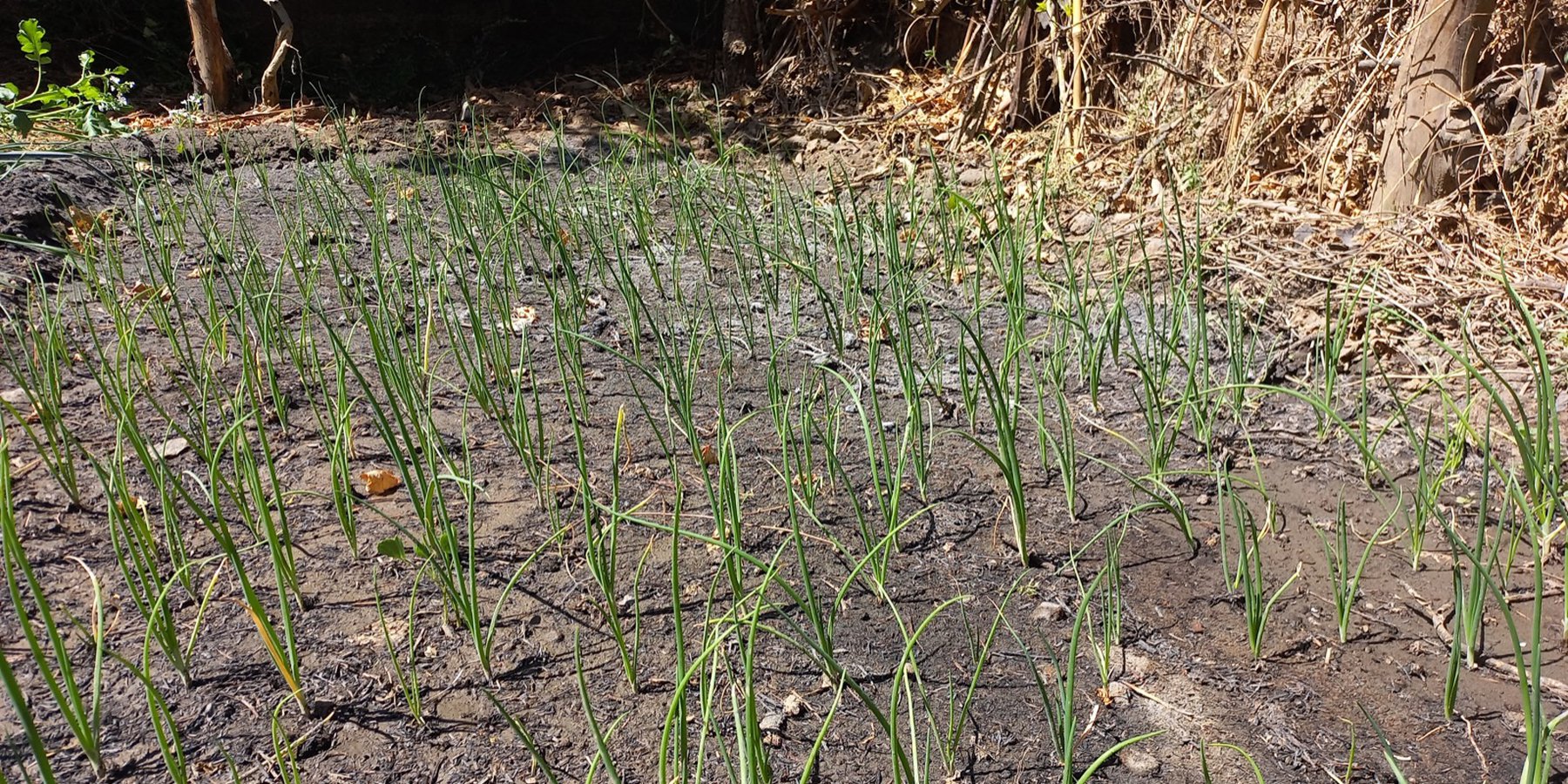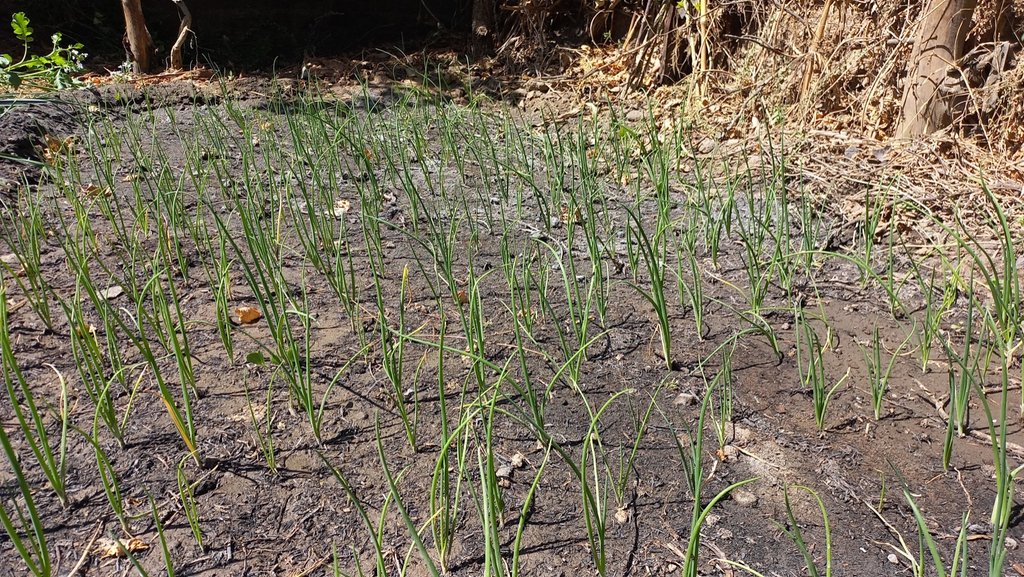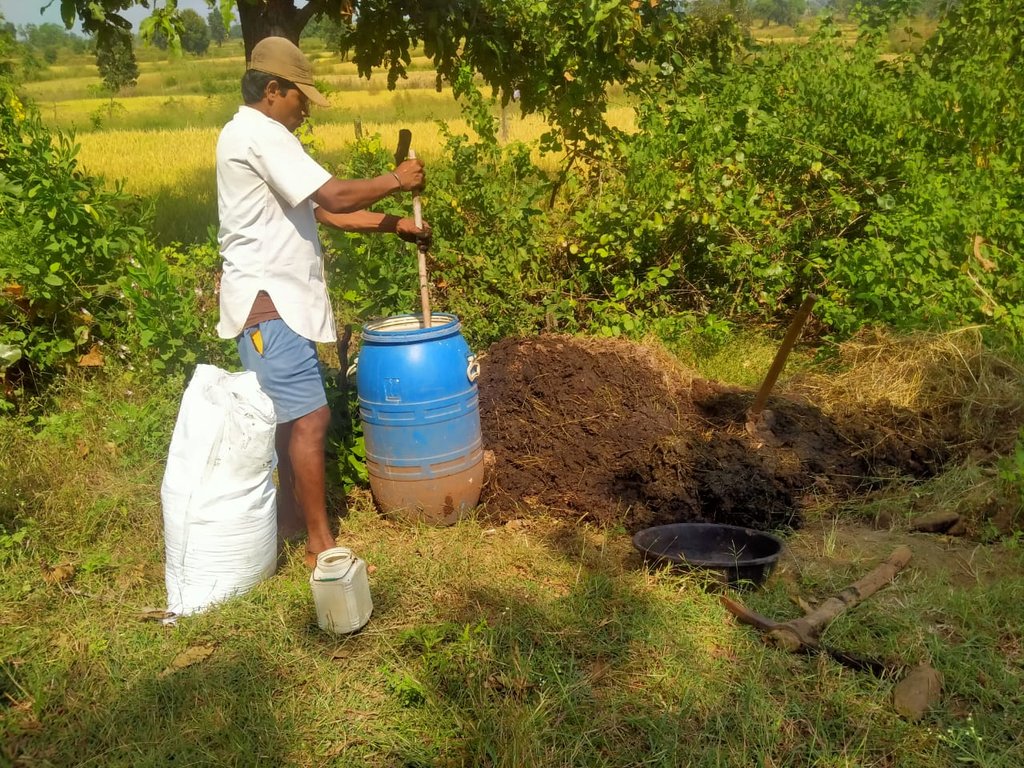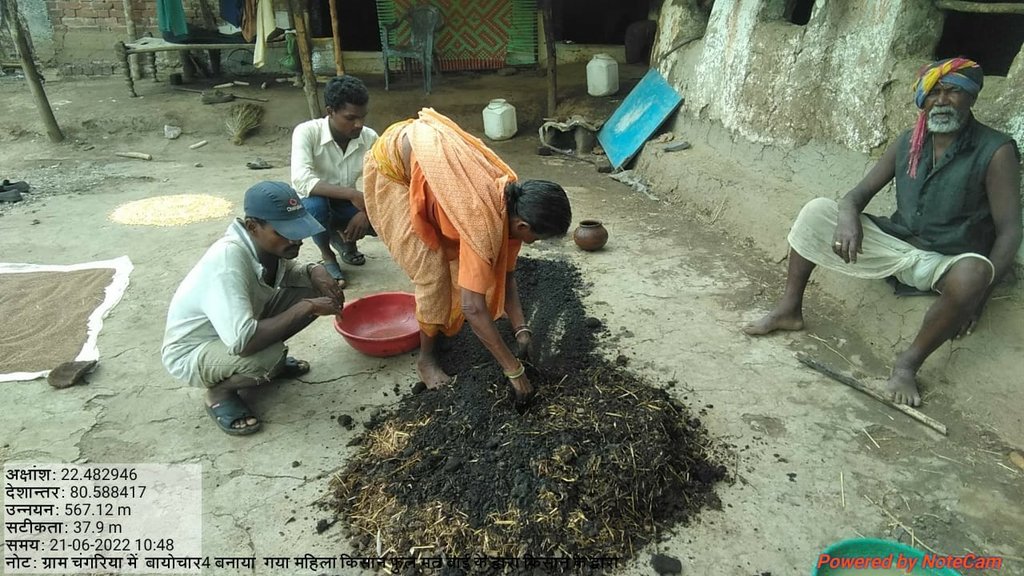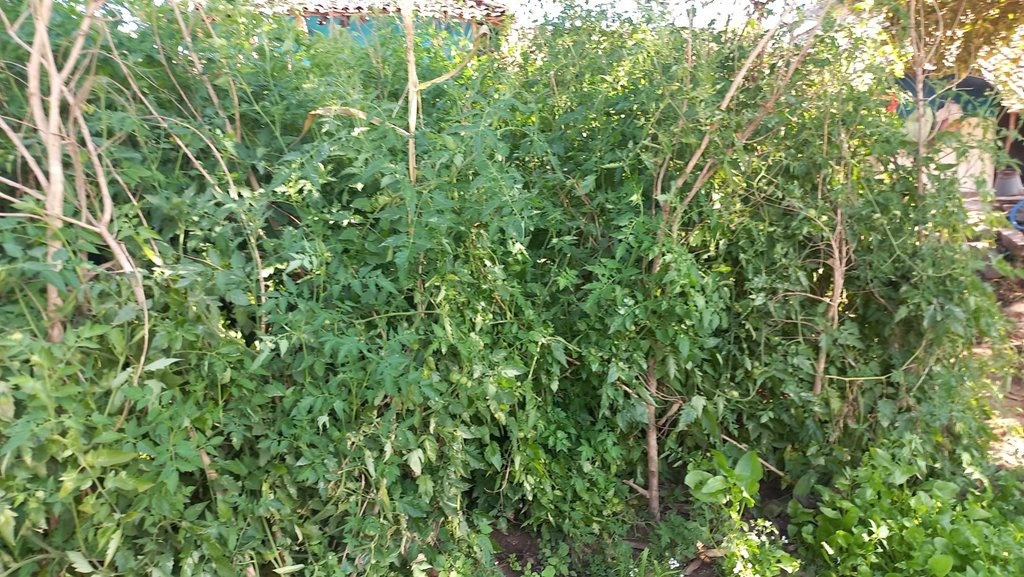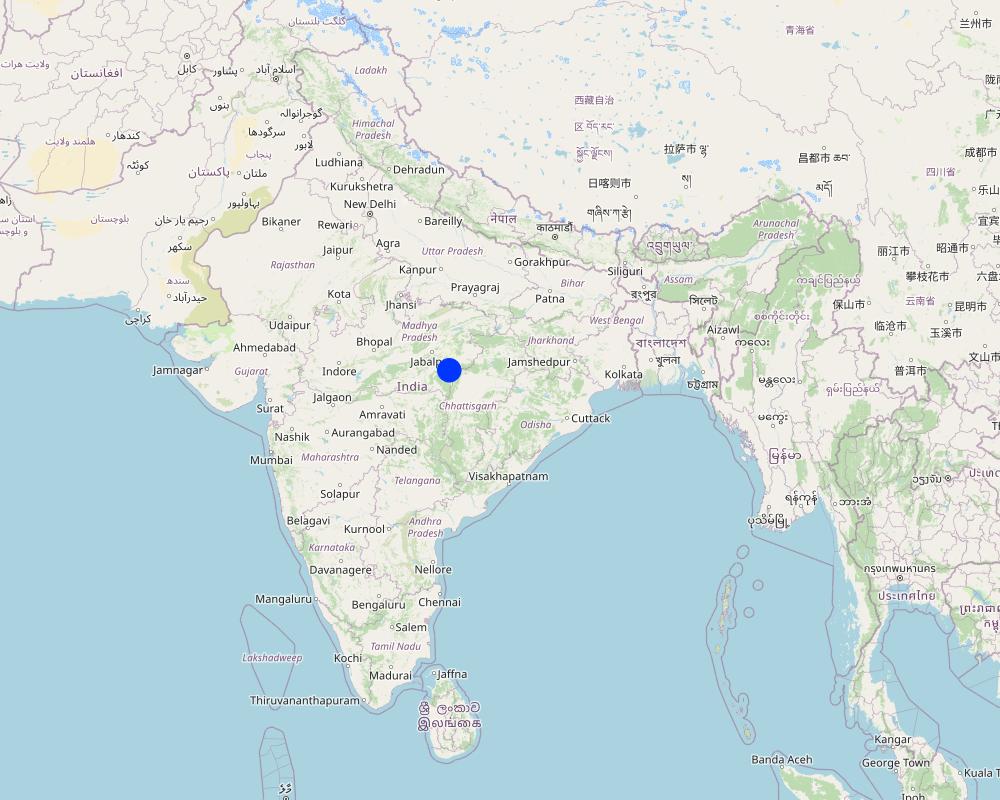Biochar Application on Homestead Land [ប្រទេសឥណ្ឌា]
- ការបង្កើត៖
- បច្ចុប្បន្នភាព
- អ្នកចងក្រង៖ Santosh Gupta
- អ្នកកែសម្រួល៖ Noel Templer, Stephanie Katsir, Kim Arora, Tabitha Nekesa, Ahmadou Gaye, Siagbé Golli
- អ្នកត្រួតពិនិត្យច្រើនទៀត៖ Udo Höggel, Sally Bunning
technologies_6693 - ប្រទេសឥណ្ឌា
ពិនិត្យមើលគ្រប់ផ្នែក
ពង្រីកមើលទាំងអស់ បង្រួមទាំងអស់1. ព័ត៌មានទូទៅ
1.2 ព័ត៌មានលម្អិតពីបុគ្គលសំខាន់ៗ និងស្ថាប័នដែលចូលរួមក្នុងការវាយតម្លៃ និងចងក្រងឯកសារនៃបច្ចេកទេស
ឈ្មោះគម្រោងដែលបានចងក្រងឯកសារ/ វាយតម្លៃលើបច្ចេកទេស (បើទាក់ទង)
Soil protection and rehabilitation for food security (ProSo(i)l)ឈ្មោះអង្គភាពមួយ (ច្រើន) ដែលបានចងក្រងឯកសារ/ វាយតម្លៃបច្ចេកទេស (បើទាក់ទង)
GIZ India (GIZ India) - ប្រទេសឥណ្ឌាឈ្មោះអង្គភាពមួយ (ច្រើន) ដែលបានចងក្រងឯកសារ/ វាយតម្លៃបច្ចេកទេស (បើទាក់ទង)
Alliance Bioversity and International Center for Tropical Agriculture (Alliance Bioversity-CIAT) - ប្រទេសកេនយ៉ាឈ្មោះអង្គភាពមួយ (ច្រើន) ដែលបានចងក្រងឯកសារ/ វាយតម្លៃបច្ចេកទេស (បើទាក់ទង)
Ecociate Consultants (Ecociate Consultants) - ប្រទេសឥណ្ឌា1.3 លក្ខខណ្ឌទាក់ទងទៅនឹងការប្រើប្រាស់ទិន្នន័យដែលបានចងក្រងតាមរយៈ វ៉ូខេត
អ្នកចងក្រង និង(បុគ្គលសំខាន់ៗ)យល់ព្រមទទួលយកនូវលក្ខខណ្ឌនានាទាក់ទងទៅនឹងការប្រើប្រាស់ទិន្នន័យដែលបានចងក្រងតាមរយៈវ៉ូខេត:
បាទ/ចា៎
1.4 សេចក្តីប្រកាសស្តីពីចីរភាពនៃការពណ៌នាពីបច្ចេកទេស
តើបច្ចេកទេសដែលបានពណ៌នានេះមានបញ្ហាដែលផ្តោតលើការធ្លាក់ចុះគុណភាពដី, បើដូច្នេះវាមិនអាចត្រូវបានប្រកាសថាជាបច្ចេកទេសនៃការគ្រប់គ្រងប្រកបដោយចីរភាពទេ?
ទេ
មតិយោបល់:
The technology described here is the application of biochar on homestead land. This technology positively impacts soil health and crop production.
2. ការពណ៌នាពីបច្ចេកទេស SLM
2.1 ការពណ៌នាដោយសង្ខេបពីបច្ចេកទេស
និយមន័យបច្ចេកទេស:
Biochar is a carbon-rich solid formed from the organic residue by pyrolysis. Biochar is a stable, highly water and nutrient-retentive product that benefits microorganisms and has a very high carbon sequestration potential. Farmers in the project area have applied it to their homesteads or kitchen gardens.
2.2 ការពណ៌នាលម្អិតពីបច្ចេកទេស
ការពណ៌នា:
Biochar, a sustainable soil amendment, is produced through pyrolysis, where organic matter such as wood or agricultural waste is heated in a closed container under low-oxygen conditions. Applying biochar to soil has numerous benefits for improving soil health, such as enhancing soil fertility, reducing greenhouse gas emissions, improving soil microbiology, and reducing soil erosion. One of the most significant benefits of biochar is its ability to sequester atmospheric carbon dioxide into the soil, which can help mitigate climate change by reducing the amount of carbon dioxide in the atmosphere. Biochar can also remove contaminants from soil and water and serve as a compost component.
Biochar also reduces the emission of ammonia and carbon dioxide (Cabeza et al. 2018), lowers soil compactness, optimizes compost (Liang et al. 2010), improves water retention and the sorption of heavy metals, increases the availability of micronutrients for plants and increases the pH of soils (Van Zwieten et al. 2010). Biochar also stimulates the growth of rhizosphere microorganisms and mycorrhizal fungi (Głuszek et al. 2017). These bacteria and fungi may also promote plant growth (Compant et al. 2010). The pH values of biochars are positively correlated with the formation of carbonates and the contents of inorganic alkalis (Ding et al. 2014). The pH value of biochar ranges from 6.5 to 10.8. It is advisable to test the pH values of both soils and biochar to reach at the optimal quantity of biochar to be applied in the field.
In the Mandla district, agriculture is the backbone of the economy, and farmers are constantly adopting new farming technologies to increase their agricultural production. One such technology that has positively impacted more than a thousand farmers in the region is the application of biochar in homestead land under a GIZ-funded Soil protection and rehabilitation of degraded soil for food security in India (ProSoil) program. Biochar in this region is prepared using low cost Biochar Kiln units developed by Indian council of agriculture research institutions, traditional methods, such as digging soil pits and burning organic residue while covering its top with soil. Since the Mandla district is a high-rainfall region, most farmers broadcast biochar over their fields before growing rabi (winter) crops. Commonly grown rabi crops in this region are mustard, vegetables, and maize.
Farmers in the Mandla district use small units of biochar production. The recovery rate of biochar is 20%, with a capacity of 100kg of organic material. The application rate per unit area varies from farmer to farmer.
1. Landholding: Farmers with more extensive land holdings or generally rotationally applied biochar in the parcels.
2. The intervention of biochar application was introduced in this region in 2020. The new practice is evolving, and the application rate of biochar varies from farmer to farmer depending on the availability of raw materials and labour availability (family/hired)
The most suitable biochar application rate is 10 − 20 t/ha. Moreover, it is essential to consider the compatibility and complementarity between biochar, soil texture, and management factors such as Nitrogen (N) application rate, pH values and growing environment into consideration (Yang Gao et al., 2021). More scientific studies are needed to define the quantity of biochar needed based on the local soil conditions. However, the current quantity of applications is very low compared to suggested in secondary documents.
The immediate effects of biochar application on crop production have been significant, with farmers reporting an increase in crop yield by 20-25% across most crops. Simple indicators such as increased grain weight and improved grain quality imply that the crop produced is of higher quality. Another critical benefit highlighted by farmers of biochar application is the retention of soil moisture over a longer duration compared to non-treated fields. Biochar can help the farmers of the Mandla district increase their agricultural productivity while promoting sustainable land use practices.
2.3 រូបភាពនៃបច្ចេកទេស
កំណត់សម្គាល់ទូទៅនៃរូបថត/រូភាព:
All the photos have been taken with the consent of participants
2.5 ប្រទេស/តំបន់/ទីតាំងកន្លែង ដែលបច្ចេកទេសត្រូវបានអនុវត្ត និងបានគ្រប់ដណ្តប់ដោយការវាយតម្លៃនេះ
ប្រទេស:
ប្រទេសឥណ្ឌា
តំបន់/រដ្ឋ/ខេត្ត:
Madhya Pradesh
បញ្ជាក់បន្ថែមពីលក្ខណៈនៃទីតាំង:
Mandla
បញ្ជាក់ពីការសាយភាយនៃបច្ចេកទេស:
- អនុវត្តនៅកន្លែងជាក់លាក់មួយ/ ប្រមូលផ្តុំនៅតំបន់តូចៗ
តើបច្ចេកទេស (មួយ ឬច្រើន) ទាំងនោះស្ថិតនៅក្នុងតំបន់ការពារជាអចិន្ត្រៃយ៍ណាមួយដែរឬទេ?
ទេ
មតិយោបល់:
Field visits in Gabri and Changariya villages of Bichhhiya block were conducted to understand the technology
Map
×2.6 កាលបរិច្ឆេទនៃការអនុវត្ត
បង្ហាញឆ្នាំនៃការចុះអនុវត្ត:
2020
2.7 ការណែនាំពីបច្ចេកទេស
សូមបញ្ជាក់តើបច្ចេកទេសត្រូវបានណែនាំឱ្យអនុវត្តដោយរបៀបណា:
- ពេលកំពុងពិសោធន៍
- តាមរយៈគម្រោង / អន្តរាគមន៍ពីខាងក្រៅ
មតិយោបល់ (ប្រភេទនៃគម្រោង ។ល។):
The application of biochar for improving soil health and crop production was introduced in this region through the GIZ-funded program
3. ចំណាត់ថ្នាក់នៃបច្ចេកទេស SLM
3.1 គោលបំណងចម្បង (១ ឬច្រើន) នៃបច្ចេកទេសនេះ
- ធ្វើឱ្យប្រសើរឡើងនូវផលិតកម្ម
- កាត់បន្ថយ, បង្ការ, ស្តារឡើងវិញនូវការធ្លាក់ចុះគុណភាពដី
- អភិរក្សប្រព័ន្ធអេកូឡូស៊ី
- កាត់បន្ថយការប្រែប្រួលអាកាសធាតុ និងផលប៉ះពាល់របស់វា
- បង្កើតផលប្រយោជន៍សេដ្ឋកិច្ច
3.2 ប្រភេទដីប្រើប្រាស់មួយប្រភេទ (ច្រើនប្រភេទ) ដែលបានអនុវត្តបច្ចេកទេស
ដីប្រើប្រាស់ចម្រុះនៅលើដីតែមួយ:
បាទ/ចា៎
បញ្ជាក់ពីប្រភេទដីច្រើនប្រភេទ (ដីដាំដំណាំ/ដីចិញ្ចឹមសត្វ/ដីព្រៃឈើ):
- កសិរុក្ខកម្ម

ដីដាំដំណាំ
- ដំណាំប្រចាំឆ្នាំ
ដំណាំប្រចាំឆ្នាំ - បញ្ជាក់ប្រភេទដំណាំ:
- ធញ្ញជាតិ - ពោត
- ធញ្ញជាតិ - ពោតសាលី
- ធញ្ញជាតិ - ស្រូវ (តំបន់ដីសើម)
- ធញ្ញជាតិ - ពោតសាលី
- legumes and pulses - lentils
- Mustard
ចំនួនសារដែលដាំដំណាំក្នុងមួយឆ្នាំ:
- 2
សូមបញ្ជាក់:
Mandla district is predominantly a rainfed region. Homestead land generally has some irrigation facilities available for Kharif (summer) and Rabi (winter) crops.
តើជាការអនុវត្តន៍ដំណាំចន្លោះ?
ទេ
តើជាការអនុវត្តន៍ដំណាំវិលជុំ?
បាទ/ចា៎
បើបាទ/ច៎ា សូមបញ្ជាក់:
Vegetable crops such as leafy vegetables, tomatoes, onions, tuber crops, mustard, and maize are commonly grown by farmers. The primary purpose of growing crops on homestead land is to fulfill household-level nutritional requirements.
មតិយោបល់:
As per the district census handbook of Mandla District 2001, the land use pattern of Mandla District is: 61% - under forest area, 21% - cropped area, 5% - not available for cultivation, 7% - under fallow land, and 2% - cultivable area. The net area irrigated is 7% of the net area sown, which has hardly increased in recent times (~9%).
3.3 បន្ទាប់ពីអនុវត្តបច្ចេកទេស តើដីប្រើប្រាស់មានការប្រែប្រួលដែររឺទេ?
បន្ទាប់ពីអនុវត្តបច្ចេកទេស តើដីប្រើប្រាស់មានការប្រែប្រួលដែររឺទេ?
- ទេ (បន្តទៅសំណួរ 3.4)
មតិយោបល់:
There has been no change in land use pattern due to project interventions.
3.4 ការផ្គត់ផ្គង់ទឹក
ការផ្គត់ផ្គង់ទឹកនៅកន្លែងអនុវត្តបច្ចេកទេស:
- ទឹកភ្លៀង និងប្រព័ន្ធស្រោចស្រព
មតិយោបល់:
Mandla has nearly 9% of its net sown area irrigated. The homestead land, where biochar is applied during the rabi season, has some irrigation from surface- or groundwater sources.
3.5 ក្រុម SLM ដែលបច្ចេកទេសស្ថិតនៅក្នុង
- កសិរុក្ខកម្ម
- ធ្វើឱ្យប្រសើរឡើងគម្របដី/ ដំណាំគម្របដី
- ការគ្រប់គ្រងជីជាតិដីតាមបែបចម្រុះ
3.6 វិធានការ SLM ដែលបញ្ចូលនូវបច្ចេកទេស

វិធានការក្សេត្រសាស្ត្រ
- A1: ដំណាំ/គម្របដី
- A2: សារធាតុសរីរាង្គ/ជីជាតិដី

វិធានការគ្រប់គ្រង
- M2: ការផ្លាស់ប្តូរការគ្រប់គ្រង/ កម្រិតអាំងតង់ស៊ីតេ
មតិយោបល់:
The application of biochar in the field has improved the water-holding capacity of the soil along with enhanced microbial activities. This has resulted in better and long-duration vegetation as farmers are in position to cultivate vegetables throughout the year.
3.7 កំណត់ប្រភេទនៃការធ្លាក់ចុះគុណភាពដីសំខាន់ៗដែលបច្ចេកទេសនេះបានដោះស្រាយ

ការហូរច្រោះដីដោយសារទឹក
- Wt: ការបាត់ដីស្រទាប់លើដោយការហូរច្រោះ

ការធ្លាក់ចុះសារធាតុគីមីក្នុងដី
- Cp: ការបំពុលដី

ការបាត់បង់រូបសាស្ត្រនៃដី
- Pc: ការហាប់ណែន
- Pu: បាត់បង់នូវផលិតភាពជីវៈដោយសារសកម្មភាពផ្សេងៗ

ការធ្លាក់ចុះជីវសាស្ត្រនៃដី
- Bc: ការថយចុះនូវគម្របរុក្ខជាតិ
- Bl: ការបាត់បង់មីក្រូ និងម៉ាក្រូសរីរាង្គរបស់ដី
មតិយោបល់:
Biochar acts as soil amendment which helps in improving soil health and status of nutrients in the soil. Some studies have also suggested increase in soil organic carbon as a result of biochar application. Farmers in the project area were also advised to reduce the tillage practices to minimise the soil disturbance.
3.8 ការពារ កាត់បន្ថយ ឬស្តារឡើងវិញនៃការធ្លាក់ចុះគុណភាពដី
បញ្ជាក់ពីគោលដៅរបស់បច្ចេកទេស ដែលផ្តោតទៅការធ្លាក់ចុះគុណភាពដី:
- ការការពារការធ្លាក់ចុះគុណភាពដី
- ការកាត់បន្ថយការធ្លាក់ចុះគុណភាពដី
មតិយោបល់:
Prior to the application of biochar, farmers were applying synthetic fertilisers and pesticide which was degrading the land. The replacement of synthetic fertilisers with Biochar (also FYM and cow urine mixed with it) has prevented further soil degradation.
4. បច្ចេកទេសជាក់លាក់ សកម្មភាពអនុវត្ត ធាតុចូល និងថ្លៃដើម
4.1 គំនូសបច្ចេកទេសនៃបច្ចេកទេសនេះ
លក្ខណៈពិសេសនៃបច្ចេកទេស (ទាក់ទងនឺងគំនូរបច្ចេកទេស):
The drawing presented here is of a biochar kiln unit being developed by the Central Research Institute for Dryland Agriculture (CRIDA) in India for Biochar preparation. A similar unit was used by the land users in the project area. There were some farmers who also did some modifications to make it friendly for the local context. More details about this unit can be obtained from the following sources.
http://www.nicra-icar.in/nicrarevised/images/Books/Biochor%20Bulletin.pdf
http://icar-crida.res.in/Pubs/Biochar%20Research%20Bulletin%20March%202018.pdf (for a description of the HOW to make biochar)
ឈ្មោះអ្នកនិពន្ធ:
Central Research Institute for Dryland Agriculture (CRIDA)
4.2 ព័ត៌មានទូទៅដែលពាក់ព័ន្ធនឹងការគណនាធាតុចូល និងថ្លៃដើម
កំណត់របៀបនៃការគណនាថ្លៃដើម និងធាតុចូល:
- ក្នុងតំបន់អនុវត្តបច្ចេកទេស
កំណត់ទំហំ និងឯកត្តាផ្ទៃដី:
1 Ha
ផ្សេងៗ/ រូបិយប័ណ្ណជាតិ (បញ្ជាក់):
INR
បើពាក់ព័ន្ធសូមកំណត់អត្រាប្តូរប្រាក់ពីដុល្លាទៅរូបិយប័ណ្ណតំបន់ (ឧ. 1 ដុល្លារ = 79.9 រៀលនៃរូបិយប័ណ្ណប្រេស៊ីល) ៖ 1 ដុល្លារ =:
82,5
កំណត់ថ្លៃឈ្នួលជាមធ្យមនៃការជួលកម្លាំងពលកម្មក្នុងមួយថ្ងៃ:
204
4.3 សកម្មភាពបង្កើត
| សកម្មភាព | រយៈពេល (រដូវកាល) | |
|---|---|---|
| 1. | Purchase of Biochar Kiln Unit | Once in 4-5 years |
មតិយោបល់:
Since it's a seasonal activity there are not many activities which can be categorised here.
4.4 ថ្លៃដើម និងធាតុចូលដែលត្រូវការសម្រាប់ការបង្កើតបច្ចេកទេស
| បញ្ជាក់ពីធាតុចូល | ឯកតា | បរិមាណ | ថ្លៃដើមក្នុងមួយឯកតា | ថ្លៃធាតុចូលសរុប | % នៃថ្លៃដើមដែលចំណាយដោយអ្នកប្រើប្រាស់ដី | |
|---|---|---|---|---|---|---|
| សម្ភារៈ | Biochar Kiln unit | Number | 1,0 | 9000,0 | 9000,0 | 10,0 |
| សម្ភារៈ | Transportation | LS | 1,0 | 2000,0 | 2000,0 | 10,0 |
| ថ្លៃដើមសរុបក្នុងការបង្កើតបច្ចេកទេស | 11000,0 | |||||
| ថ្លៃដើមសរុបក្នុងការបង្កើតបច្ចេកទេសគិតជាដុល្លារ | 133,33 | |||||
ប្រសិនបើអ្នកប្រើប្រាស់ដីមិនមានថ្លៃដើម 100% សូមបញ្ជាក់ថានរណាដែលចំណាយថ្លៃដើមដែលនៅសល់:
Project has financially supported the local environment committes in purchase and setting up of the Biochar Kiln units
មតិយោបល់:
Biochar is prepared by a low-cost method:
1. Using Soil pit kiln - Human Labor cost is usually applied as no capital cost is involved in this method.
2. Using Portable Kiln - Its cost generally range from 12000 -14000 Rs if purchased from the ICAR institutions and their associated fabricators. Sometimes farmers also get it made from the local fabricators which cost Rs 4000-6000
Refer to the following Study: Biochar production from Lantana camara (invasive species);-
https://qcat.wocat.net/en/wocat/technologies/view/technologies_6690/
4.5 សកម្មភាពថែទាំ
| សកម្មភាព | ពេលវេលា/ ភាពញឹកញាប់ | |
|---|---|---|
| 1. | Preparation of Biochar using the Lantana Camara | After the monsoon season (September) |
| 2. | Preparing the biochar for application by mixing it with cow dung and cow urine | During Rabi Season (Oct-Nov) |
| 3. | Application of Biochar in homestead land | During Rabi Season (Oct-Nov) |
មតិយោបល់:
A low-cost method of biochar preparation (traditional soil pit or portable kiln method) is used for biochar preparation. Due to simplicity in design, barely any cost is involved in the maintenance of the unit.
4.6 កំណត់ថ្លៃដើមសម្រាប់ការថែទាំ/ សកម្មភាពរបស់បច្ចេកទេស (ក្នុងរយៈពេលមួយឆ្នាំ)
| បញ្ជាក់ពីធាតុចូល | ឯកតា | បរិមាណ | ថ្លៃដើមក្នុងមួយឯកតា | ថ្លៃធាតុចូលសរុប | % នៃថ្លៃដើមដែលចំណាយដោយអ្នកប្រើប្រាស់ដី | |
|---|---|---|---|---|---|---|
| កម្លាំងពលកម្ម | Transportation of biomass and its drying before biochar production | Person-day | 2,0 | 200,0 | 400,0 | 100,0 |
| កម្លាំងពលកម្ម | Preparation of Biochar by family members | Person-day | 2,0 | 200,0 | 400,0 | 100,0 |
| កម្លាំងពលកម្ម | Mixing biochar with cow dung and cow urine and making it ready for the application | Person-day | 1,0 | 200,0 | 200,0 | 100,0 |
| កម្លាំងពលកម្ម | Biochar Application | Person-day | 1,0 | 200,0 | 200,0 | 100,0 |
| ជី និងសារធាតុពុល | Biomass for Biochar production (Approximate) | 1,0 | 500,0 | 500,0 | 100,0 | |
| ជី និងសារធាតុពុល | Cow dung | kg | 20,0 | 5,0 | 100,0 | 100,0 |
| ជី និងសារធាតុពុល | Cow urine | kg | 20,0 | 5,0 | 100,0 | 100,0 |
| ថ្លៃដើមសរុបសម្រាប់ការថែទាំដំណាំតាមបច្ចេកទេស | 1900,0 | |||||
| ថ្លៃដើមសរុបសម្រាប់ការថែទាំដំណាំតាមបច្ចេកទេសគិតជាដុល្លារ | 23,03 | |||||
មតិយោបល់:
A majority of the cost mentioned here is an opportunity cost for the farmers as they do manage all these expenses internally with available family labour and input materials such as cow dung, cow urine biomass etc.
4.7 កត្តាសំខាន់បំផុតដែលមានឥទ្ធិពលដល់ការចំណាយ
ពណ៌នាពីកត្តាប៉ះពាល់ចម្បងៗទៅលើថ្លៃដើម:
The primary factor affecting the cost is the labor cost for applying biochar to the field and the easy availability of biomass/crop residues/Lantana for biochar production
5. លក្ខណៈបរិស្ថានធម្មជាតិ និងមនុស្ស
5.1 អាកាសធាតុ
បរិមាណទឹកភ្លៀងប្រចាំឆ្នាំ
- < 250 មម
- 251-500 មម
- 501-750 មម
- 751-1,000 មម
- 1,001-1,500 មម
- 1,501-2,000 មម
- 2,001-3,000 មម
- 3,001-4,000 មម
- > 4,000 មម
កំណត់បរិមាណទឹកភ្លៀង (បើដឹង) ជា មីលីម៉ែត្រ:
1427,70
លក្ខណៈពិសេស/ មតិយោបល់លើរដូវភ្លៀង:
Monsoon season is June-September which has the majority of the rainfall
បញ្ជាក់ឈ្មោះឯកសារយោងនៃស្ថានីយឧតុនិយម:
District at glance report of Ministry of Water Resources, Central Groundwater Board, North Central Region BHOPAL, 2013
តំបន់កសិអាកាសធាតុ
- មានភ្លៀងមធ្យម
- មានភ្លៀងតិចតួច
The National Bureau of Soil Survey & Land Use Planning (NBSS&LUP) developed twenty agroecological zones based on the growing period as an integrated criterion of adequate rainfall and soil groups. It delineated boundaries adjusted to district boundaries with a minimal number of regions. Mandla District of Madhya Pradesh lies in a hot sub-humid ecoregion with red and black soil. The length of the growing period varies from block to block based on the availability of irrigation with farmers. Thus both sub-humid and semi-arid agroclimatic zones are being considered for the District.
Precipitation: 1000–1500 mm; Potential Evapotranspiration: 1300–1500 mm; Length of Growing Period: 150–180 days
5.2 សណ្ឋានដី
ជម្រាលជាមធ្យម:
- រាបស្មើ (0-2%)
- ជម្រាលតិចតួច (3-5%)
- មធ្យម (6-10%)
- ជម្រាលខ្ពស់បន្តិច (11-15%)
- ទីទួល (16-30%)
- ទីទួលចោត (31-60%)
- ទីទួលចោតខ្លាំង (>60%)
ទម្រង់ដី:
- ខ្ពង់រាប
- កំពូលភ្នំ
- ជម្រាលភ្នំ
- ជម្រាលទួល
- ជម្រាលជើងភ្នំ
- បាតជ្រលងភ្នំ
តំបន់តាមរយៈកម្ពស់ :
- 0-100 ម
- 101-500 ម
- 501-1,000 ម
- 1,001-1,500 ម
- 1,501-2,000 ម
- 2,001-2,500 ម
- 2,501-3,000 ម
- 3,001-4,000 ម
- > 4,000 ម
បញ្ជាក់ថាតើបច្ចេកទេសនេះត្រូវបានអនុវត្តន៍នៅក្នុង:
- មិនពាក់ព័ន្ធទាំងអស់
មតិយោបល់ និងបញ្ចាក់បន្ថែមអំពីសណ្ឋានដី :
Mandla District is hilly and forested (Satpura hill range) and highly undulating with a narrow strip of cultivated plains in the valley portion of the river and rivulet. The plateau is in the northern part, formed by basalt and east-west trending hills in the southern part. The highest elevation is 934m ASL in the northern region, and the lowest elevation is around 400m ASL.
5.3 ដី
ជម្រៅដីជាមធ្យម:
- រាក់ខ្លាំង (0-20 សម)
- រាក់ (21-50 សម)
- មធ្យម (51-80 សម)
- ជ្រៅ (81-120 សម)
- ជ្រៅខ្លាំង (> 120 សម)
វាយនភាពដី (ស្រទាប់លើ):
- គ្រើម/ មានពន្លឺ (ខ្សាច់)
- មធ្យម (ល្បាយ, ល្បាប់)
វាយនភាពដី (> 20 សម ស្រទាប់ក្នុង):
- មធ្យម (ល្បាយ, ល្បាប់)
- ម៉ត់/ ធ្ងន់ (ឥដ្ឋ)
សារធាតុសរីរាង្គនៅស្រទាប់ដីខាងលើ:
- ទាប (<1%)
បើអាចសូមភ្ជាប់ការពណ៌នាពីដីឱ្យបានច្បាស់ ឬព័ត៌មានដែលអាចទទួលបាន ឧ. ប្រភេទដី, pH ដី/ ជាតិអាស៊ីត, សមត្ថភាពផ្លាស់ប្តូរកាចុង, វត្តមាននីត្រូសែន, ភាពប្រៃ ។ល។:
The soils in the area are generally clayey loam types with sandy loam soil in some areas. In the northern and central parts of the District, the undulating plateau with mounds is covered with slightly deep soil. Regarding the classification of ‘Soils of the World,’ the soils of Mandla are characterized as ‘brown earth.’ These types of soils have developed from granite gneiss and quartzite schist complexes.
5.4 ទឹកដែលអាចទាញមកប្រើប្រាស់បាន និងគុណភាពទឹក
នីវ៉ូទឹកក្រោមដី:
5-50 ម
ទឹកលើដីដែលអាចទាញយកប្រើប្រាស់បាន:
កម្រិតមធ្យម
គុណភាពទឹក (មិនបានធ្វើប្រត្តិកម្ម):
ទឹកពិសារដែលគ្មានគុណភាព (តម្រូវឱ្យមានការសំអាត)
គុណភាពទឹក គឺផ្តោតទៅលើ៖:
ទាំងទឹកក្រោមដី និងលើផ្ទៃដី
តើមានបញ្ហាភាពទឹកប្រៃហូរចូលមកដែរឬទេ?
ទេ
តើទឹកជំនន់កំពុងកើតមាននៅតំបន់នេះដែររឺទេ?
ទេ
មតិយោបល់ និងលក្ខណៈពិសេសផ្សេងៗទៀតលើគុណភាព និងបរិមាណទឹក :
The pre-monsoon groundwater level in the area ranges from 3 to 14 meters below ground level. (District at Glance, Mandla, Central Ground Water Board, 2013). The locations have a river flowing close to the area; however, access to the surface and sub-surface water is a primary concern. Basaltic lava flows of the Deccan trap underlie the Mandla District. All blocks of the district including project block Bichhiya are categorized as safe blocks. The net groundwater availability in the district is 53779 hectare meters (ham), and the groundwater draft for all uses is 8205 ham, making the Stage of Groundwater Development 15% as a whole for the district. The area's topography, soil, and geology do not let water remain for long durations, causing water scarcity in summer. The irrigation facilities are poor and limited to areas adjoining dams and canals.
5.5 ជីវៈចម្រុះ
ភាពសម្បូរបែបនៃប្រភេទ:
- ខ្ពស់
ភាពសម្បូរបែបនៃទីជម្រក:
- ខ្ពស់
មតិយោបល់ និងលក្ខណៈពិសេសផ្សេងទៀតលើជីវចម្រុះ:
The area is surrounded by the Kanha National Park and Phen Wildlife Sanctuary, with a good presence of forest area. Thus biodiversity is outstanding. Ecological assessment report in Mandla (where this Technology is applied) showed improved biodiversity on common lands under village governance compared to open-access or commons under government ownership. On average, the Shannon diversity index (https://www.statology.org/shannon-diversity-index/) of managed common lands was 1.45 compared to 0.42 for the open access or ungoverned commons. Most of the sites under open access lands are infested by Lantana camara, which is the main reason for the lower biomass and diversity of the ungoverned grounds. More information about the biodiversity in Mandla can be read through the following link.
https://mpsbb.mp.gov.in/completedProject/MB.pdf
5.6 លក្ខណៈនៃអ្នកប្រើប្រាស់ដីដែលអនុវត្តបច្ចេកទេស
នៅមួយកន្លែង ឬពនេចរ :
- នៅមួយកន្លែង
ទីផ្សារនៃប្រព័ន្ធផលិតកម្ម:
- ពាក់កណ្តាលពាណិជ្ជកម្ម (ផ្គត់ផ្គង់ខ្លួនឯង/ ពាណិជ្ជកម្ម)
ចំណូលក្រៅកសិកម្ម:
- ច្រើនជាង 50% នៃចំណូល
កម្រិតជីវភាព:
- មិនល្អ
- មធ្យម
ឯកជន ឬក្រុម:
- ធ្វើខ្លួនឯង/ គ្រួសារ
កម្រិតប្រើប្រាស់គ្រឿងយន្ត:
- ប្រើកម្លាំងពលកម្ម
- ប្រើកម្លាំងសត្វ
យេនឌ័រ:
- ស្ត្រី
- បុរស
អាយុរបស់អ្នកប្រើប្រាស់ដី:
- យុវវ័យ
- វ័យកណ្តាល
សូមបញ្ជាក់ពីលក្ខណៈពាក់ព័ន្ធផ្សេងទៀតអំពីអ្នកប្រើប្រាស់ដី:
A large majority of the user belonging to the tribal community, including some households from an ethnic community called Baiga.
5.7 ទំហំផ្ទៃដីជាមធ្យមនៃដីប្រើប្រាស់ដោយអ្នកប្រើប្រាស់ដី ក្នុងការអនុវត្តបច្ចេកទេស
- < 0.5 ហិកតា
- 0.5-1 ហិកតា
- 1-2 ហិកតា
- 2-5 ហិកតា
- 5-15 ហិកតា
- 15-50 ហិកតា
- 50-100 ហិកតា
- 100-500 ហិកតា
- 500-1,000 ហិកតា
- 1,000-10,000 ហិកតា
- > 10,000 ហិកតា
តើផ្ទៃដីនេះចាត់ទុកជាទំហំកម្រិតណាដែរ ខ្នាតតូច មធ្យម ឬខ្នាតធំ (ធៀបនឹងបរិបទតំបន់)?
- ខ្នាតតូច
មតិយោបល់:
Around 2000 farmers in different crops have applied the technology
5.8 ភាពជាម្ចាស់ដី កម្មសិទ្ធប្រើប្រាស់ដី និងកម្មសិទ្ធប្រើប្រាស់ទឹក
ភាពជាម្ចាស់ដី:
- ភូមិ
- ឯកជន មានកម្មសិទ្ធ
កម្មសិទ្ធិប្រើប្រាស់ដី:
- ឯកជន
កម្មសិទ្ធប្រើប្រាស់ទឹក:
- ជាក្រុម (មានដែនកំណត់)
- ឯកជន
តើកម្មសិទ្ធប្រើប្រាស់ដី គឺផ្អែកលើប្រព័ន្ធច្បាប់បែបបុរាណ?
បាទ/ចា៎
សូមបញ្ជាក់:
The concerned authorities have issued landowners the land certificates.
5.9 ការប្រើប្រាស់សេវាកម្ម និងហេដ្ឋារចនាសម្ព័ន្ធ
សុខភាព:
- មិនល្អ
- មធ្យម
- ល្អ
ការអប់រំ:
- មិនល្អ
- មធ្យម
- ល្អ
ជំនួយបច្ចេកទេស:
- មិនល្អ
- មធ្យម
- ល្អ
ការងារ (ឧ. ការងារក្រៅកសិដ្ឋាន):
- មិនល្អ
- មធ្យម
- ល្អ
ទីផ្សារ:
- មិនល្អ
- មធ្យម
- ល្អ
ថាមពល:
- មិនល្អ
- មធ្យម
- ល្អ
ផ្លូវ និងការដឹកជញ្ជូន:
- មិនល្អ
- មធ្យម
- ល្អ
ទឹកផឹក និងអនាម័យ:
- មិនល្អ
- មធ្យម
- ល្អ
សេវាកម្មហិរញ្ញវត្ថុ:
- មិនល្អ
- មធ្យម
- ល្អ
Advisory and extension (limited to only project teams):
- មិនល្អ
- មធ្យម
- ល្អ
មតិយោបល់:
Over the years, there has been a development focus from both the Government and other civil society organizations to bring out the facilities at the door of communities, which has improved access of different facilities.
6. ផលប៉ះពាល់ និងការសន្និដ្ឋាន
6.1 ផលប៉ះពាល់ក្នុងបរិវេណអនុវត្តបច្ចេកទេសដែលកើតមាន
ផលប៉ះពាល់លើសេដ្ឋកិច្ចសង្គម
ផលិតផល
ផលិតកម្មដំណាំ
មតិយោបល់/ ការបញ្ជាក់:
There has not been any systematic impact assessment study to quantify the impact of the intervention. However, in discussions with farmers and implementing agencies during the field visit, an increase of 20-25% in the production of farm products was reported.
គុណភាពដំណាំ
មតិយោបល់/ ការបញ្ជាក់:
Change in crop weight and colour is observed by farmers
ការគ្រប់គ្រងដី
មតិយោបល់/ ការបញ្ជាក់:
Improved Soil Health is indicated by farmers based on their observation of improved soil structure, water-holding capacity and soil texture
ចំណូល និងថ្លៃដើម
ចំណូលក្នុងកសិដ្ឋាន
មតិយោបល់/ ការបញ្ជាក់:
On the account of improved productivity, farmers have reported an increase in their income. However, there has not been any systematic study on the same.
ផលប៉ះពាល់ទៅលើវប្បធម៌សង្គម
ចំណេះដឹង SLM / ការធ្លាក់ចុះគុណភាពដី
មតិយោបល់/ ការបញ្ជាក់:
The preparation of biochar from invasive species and its application to soil improved the understanding of farmers on the negative impact of invasive species and advantages of biochar application
ផលប៉ះពាល់ទៅលើអេកូឡូស៊ី
ដី
សំណើមដី
មតិយោបល់/ ការបញ្ជាក់:
Soil structure improved by biochar application, improving water holding capacity of soil
ការបាត់បង់ដី
មតិយោបល់/ ការបញ្ជាក់:
Reduction in soil erosion due to improvement in soil structure
ដីហាប់
មតិយោបល់/ ការបញ្ជាក់:
Reduction in soil compaction due to improvement in soil structure
សារធាតុសរីរាង្គដី/ការបូនក្រោមដី
មតិយោបល់/ ការបញ្ជាក់:
Based on the observation of farmers and implementing agency, random soil tests of farmers have indicated a slight increase in soil organic carbon
ជីវចម្រុះ៖ ដំណាំ, សត្វ
ប្រភេទរាតត្បាត
មតិយោបល់/ ការបញ្ជាក់:
Reduction in invasive alien species named lantana cantara which was uprooted for preparing biochar
ការកាត់បន្ថយហានិភ័យនៃគ្រោះមហន្តរាយ និងគ្រោះអាកាសធាតុ
អាកាសធាតុ
មតិយោបល់/ ការបញ្ជាក់:
Improve soil health create an enabling environment for soil micro-organism
បញ្ជាក់ពីការប៉ាន់ស្មាននៃផលប៉ះពាល់ក្នុងបរិវេណអនុវត្តបច្ចេកទេស (វាស់វែង):
All the indicated impact measures are based on discussions with farmers, implementing agencies and other stakeholders. These were reported as per their observations, eye estimations and approximation.
6.2 ផលប៉ះពាល់ក្រៅបរិវេណអនុវត្តបច្ចេកទេសដែលកើតមាន
Biochar is prepared using invasive species of Lantana Camara. Its eradication from private and commercial land improves the ecosystem.
វាយតម្លៃផលប៉ះពាល់ក្រៅបរិវេណអនុវត្តបច្ចេកទេស (វាស់វែង):
The scale of implementation is not large enough to have an ecosystem level impact
6.3 ភាពប្រឈម និងភាពរួសនៃបច្ចេកទេសទៅនឹងការប្រែប្រួលអាកាសធាតុ និងគ្រោះអាកាសធាតុ/ គ្រោះមហន្តរាយ (ដែលដឹងដោយអ្នកប្រើប្រាស់ដី)
ការប្រែប្រួលអាកាសធាតុ
ការប្រែប្រួលអាកាសធាតុ
| រដូវកាល | កើនឡើង ឬថយចុះ | លក្ខណៈឆ្លើយតបនៃបច្ចេកទេសទៅនឹងការប្រែប្រួលអាកាសធាតុ | |
|---|---|---|---|
| ការប្រែប្រួលអាកាសធាតុផ្សេងៗ | When biochar is added to soil, it can sequester carbon in the form of stable organic matter, which can remain in the soil for hundreds or even thousands of years. This carbon sequestration can help to reduce the amount of carbon dioxide in the atmosphere, thereby mitigating climate change. | ថយចុះ | ល្អ |
6.4 ការវិភាគថ្លៃដើម និងអត្ថប្រយោជន៍
តើផលចំណេញ និងថ្លៃដើមត្រូវបានប្រៀបធៀបគ្នាយ៉ាងដូចម្តេច (ទស្សនៈរបស់អ្នកប្រើប្រាស់ដី)?
រយៈពេលខ្លី:
វិជ្ជមាន
រយៈពេលវែង:
វិជ្ជមានខ្លាំង
តើផលចំណេញ និងការថែទាំ/ ជួសជុលត្រូវបានប្រៀបធៀបគ្នាយ៉ាងដូចម្តេច (ទស្សនៈរបស់អ្នកប្រើប្រាស់ដី)?
រយៈពេលខ្លី:
វិជ្ជមាន
រយៈពេលវែង:
វិជ្ជមានខ្លាំង
មតិយោបល់:
The benefits as indicated above are much higher than the cost involved. More importantly cost is too less as all the resources are being managed internally by the farmers.
6.5 ការទទួលយកបច្ចេកទេស
- 1-10%
បើអាច សូមបញ្ជាក់ពីបរិមាណ (ចំនួនគ្រួសារ និង/ ឬតំបន់គ្របដណ្តប់):
More than 3000 farmers
6.7 ភាពខ្លាំង/ គុណសម្បត្តិ/ ឱកាសនៃបច្ចេកទេស
| ភាពខ្លាំង/ គុណសម្បត្តិ/ ឱកាសនៅកន្លែងរបស់អ្នកប្រើប្រាស់ដី |
|---|
| Increase crop production |
| Improve the quality of farm produce |
| Improve soil water holding capacity |
| ភាពខ្លាំង/ គុណសម្បត្តិ/ ឱកាស ទស្សនៈរបស់បុគ្គលសំខាន់ៗ |
|---|
| Improved soil health |
| Mitigate climate change |
| Increase in soil nutrient content |
| Reduction in cost of inputs |
6.8 ភាពខ្សោយ/ គុណវិបត្តិ/ ហានិភ័យនៃបច្ចេកទេស និងវិធីសាស្ត្រដោះស្រាយ
| ភាពខ្សោយ/ គុណវិបត្តិ/ ហានិភ័យ ទស្សនៈរបស់អ្នកប្រើប្រាស់ដី | តើបច្ចេកទេសទាំងនោះបានដោះស្រាយបញ្ហាដូចម្តេច? |
|---|---|
| Manual labor is required for the preparation of biochar | Innovating/adopting automation in biochar preparation |
| Decentralized preparation of biochar | Developing enterprise for selling cost-effective biochar in a localized manner |
| ភាពខ្សោយ/ គុណវិបត្តិ/ ហានិភ័យ ទស្សនៈរបស់អ្នកចងក្រងឬបុគ្គលសំខាន់ៗ | តើបច្ចេកទេសទាំងនោះបានដោះស្រាយបញ្ហាដូចម្តេច? |
|---|---|
| Limited understanding of standardization of biochar quality and rate of application | Conducting more research studies and documenting experiences of farmers |
7. ឯកសារយោង និងវេបសាយ
7.1 វិធីសាស្ត្រ/ ប្រភពនៃព័ត៌មាន
- តាមការចុះទីវាល ការស្រាវជ្រាវនៅទីវាល
1
- ការសម្ភាសន៍ជាមួយអ្នកប្រើប្រាស់ដី
8
- ការសម្ភាសន៍ជាមួយអ្នកជំនាញ/ ឯកទេស
1
- ការចងក្រងពីរបាកការណ៍ និងឯកសារផ្សេងៗទៀតដែលមាន
3
តើពេលណាដែលទិន្នន័យបានចងក្រង (នៅទីវាល)?
22/02/2023
មតិយោបល់:
During the field visit, detailed discussions were held with the project implementing agency, communities, and other stakeholders to understand the process and impact of the intervention
7.2 ឯកសារយោងដែលបានចេញផ្សាយ
ចំណងជើង អ្នកនិពន្ធ ឆ្នាំ ISBN:
Significance of biochar application to the environment and economy, Babalola Aisosa Onia,⁎, Olubukola Oziegbeb, Obembe O. Olawole
មានប្រភពមកពីណា? ថ្លៃដើមប៉ុន្មាន?
https://doi.org/10.1016/j.aoas.2019.12.006
ចំណងជើង អ្នកនិពន្ធ ឆ្នាំ ISBN:
Impacts of biochar application on upland agriculture: A review, Kumuduni Niroshika Palansooriyaa,1, Yong Sik Oka,1, Yasser Mahmoud Awada, Sang Soo Leeb, Jwa-Kyung Sungc, Agamemnon Koutsospyrosd, Deok Hyun Moone
មានប្រភពមកពីណា? ថ្លៃដើមប៉ុន្មាន?
https://doi.org/10.1016/j.jenvman.2018.12.085
ចំណងជើង អ្នកនិពន្ធ ឆ្នាំ ISBN:
The role of biochar and biochar-compost in improving soil quality and crop performance: A review, Getachew Agegnehua,⁎, A.K. Srivastavab, Michael I. Birda
មានប្រភពមកពីណា? ថ្លៃដើមប៉ុន្មាន?
http://dx.doi.org/10.1016/j.apsoil.2017.06.008
ចំណងជើង អ្នកនិពន្ធ ឆ្នាំ ISBN:
Biochar physicochemical properties: pyrolysis temperature and feedstock kind effects
មានប្រភពមកពីណា? ថ្លៃដើមប៉ុន្មាន?
https://link.springer.com/article/10.1007/s11157-020-09523-3
7.3 ការភ្ជាប់ទៅកាន់ព័ត៌មានពាក់ព័ន្ធលើប្រព័ន្ធអនឡាញ
ចំណងជើង/ ពណ៌នា:
District at glance - Mandla
វេបសាយ:
http://cgwb.gov.in/District_Profile/MP/Mandla.pdf
ចំណងជើង/ ពណ៌នា:
District Census Handbook Mandla
វេបសាយ:
http://lsi.gov.in:8081/jspui/bitstream/123456789/2097/1/38136_2001_MAN.pdf
ការតភ្ជាប់ និងម៉ូឌុល
ពង្រីកមើលទាំងអស់ បង្រួមទាំងអស់ការតភ្ជាប់
គ្មានការតភ្ជាប់
ម៉ូឌុល
គ្មានម៉ូឌុល


